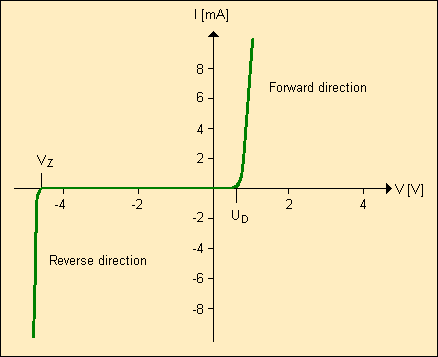| VIAS Encyclopedia provides a collection of tables and definitions commonly needed in science and engineering. |

|

Home  Electronics Electronics  Diodes Diodes  Basics Basics |
|||||||






|
|||||||
Diode - BasicsThe diode is the simplest bipolar semiconductor component. It consists of two zones, which are doped differently (pn junction). The two zones have one connection each, where the cathode is connected to the n-doped zone, and the anode to the p-doped zone.
If the cathode is connected to the negative connection of a DC voltage source and the anode is connected to the positive pole, then the diode will conduct. If this is connected in reverse, then it will have an impeding effect. The diode therefore functions like a valve, which lets the current pass only in one direction. This is also illustrated by the component's graphical symbol where the current is only allowed to flow in the direction of the arrow.
The characteristic of a diode consists of three ranges:
The current does not start to flow in the forward direction at zero V, but only at voltage Vd, the so-called forward bias. It is dependent on the semiconductor material used, and is approximately 0.6 V for silicon and for germanium approximately 0.3 V. Starting at this threshold, the current starts to rise strongly, the diode conducts.
If the polarity of the diode is reversed, then only a very small cutoff-current flows, it is said that the diode "closes". For silicon diodes, the cutoff-current lies within the range of 10 to 100 nA. If the voltage applied is increased up to the voltage Vz , then the diode will no longer withstand the "pressure" and the current will start to rise very strongly. This is the so-called breakdown voltage or Zener voltage, Vz. For normal rectifier diodes, the Zener voltage should be as high as possible (several 100 V), however for certain manufacturing purposes, it can be adjusted exactly (Zener diodes or "breakdown diodes"). A characteristic of each pn junction is the negative temperature coefficient of the forward bias. For silicon diodes, it amounts to approximately -2 mV/K and is constant over a wide temperature range. This temperature coefficient has the consequence that semiconductor circuits are always temperature sensitive. This causes problems particularly with analog high-precision circuits (AD converters, reference elements, and so on), which must be circumvented using technical circuiting tricks. The advantage of the temperature coefficient however is that a diode can also be used as a temperature sensor.
|
|||||||
Home  Electronics Electronics  Diodes Diodes  Basics Basics |
|||||||
Last Update: 2005-04-07




